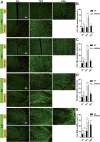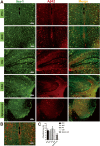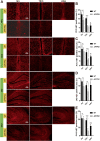Comparisons of neuroinflammation, microglial activation, and degeneration of the locus coeruleus-norepinephrine system in APP/PS1 and aging mice
- PMID: 33407625
- PMCID: PMC7789762
- DOI: 10.1186/s12974-020-02054-2
Comparisons of neuroinflammation, microglial activation, and degeneration of the locus coeruleus-norepinephrine system in APP/PS1 and aging mice
Abstract
Background: The role of microglia in Alzheimer's disease (AD) pathogenesis is becoming increasingly important, as activation of these cell types likely contributes to both pathological and protective processes associated with all phases of the disease. During early AD pathogenesis, one of the first areas of degeneration is the locus coeruleus (LC), which provides broad innervation of the central nervous system and facilitates norepinephrine (NE) transmission. Though the LC-NE is likely to influence microglial dynamics, it is unclear how these systems change with AD compared to otherwise healthy aging.
Methods: In this study, we evaluated the dynamic changes of neuroinflammation and neurodegeneration in the LC-NE system in the brain and spinal cord of APP/PS1 mice and aged WT mice using immunofluorescence and ELISA.
Results: Our results demonstrated increased expression of inflammatory cytokines and microglial activation observed in the cortex, hippocampus, and spinal cord of APP/PS1 compared to WT mice. LC-NE neuron and fiber loss as well as reduced norepinephrine transporter (NET) expression was more evident in APP/PS1 mice, although NE levels were similar between 12-month-old APP/PS1 and WT mice. Notably, the degree of microglial activation, LC-NE nerve fiber loss, and NET reduction in the brain and spinal cord were more severe in 12-month-old APP/PS1 compared to 12- and 24-month-old WT mice.
Conclusion: These results suggest that elevated neuroinflammation and microglial activation in the brain and spinal cord of APP/PS1 mice correlate with significant degeneration of the LC-NE system.
Keywords: Alzheimer’s disease; Dopaminergic; Locus coeruleus; Microglia; Noradrenergic; Norepinephrine transporter; Norepinephrine/noradrenaline; Spinal cord.
Conflict of interest statement
The authors declare that they have no competing interests.
Figures









Similar articles
-
Induced LC degeneration in APP/PS1 transgenic mice accelerates early cerebral amyloidosis and cognitive deficits.Neurochem Int. 2010 Nov;57(4):375-82. doi: 10.1016/j.neuint.2010.02.001. Epub 2010 Feb 6. Neurochem Int. 2010. PMID: 20144675
-
Distinct adrenergic system changes and neuroinflammation in response to induced locus ceruleus degeneration in APP/PS1 transgenic mice.Neuroscience. 2011 Mar 10;176:396-407. doi: 10.1016/j.neuroscience.2010.11.052. Epub 2010 Dec 1. Neuroscience. 2011. PMID: 21129451
-
Locus ceruleus controls Alzheimer's disease pathology by modulating microglial functions through norepinephrine.Proc Natl Acad Sci U S A. 2010 Mar 30;107(13):6058-63. doi: 10.1073/pnas.0909586107. Epub 2010 Mar 15. Proc Natl Acad Sci U S A. 2010. PMID: 20231476 Free PMC article.
-
Roles of tau pathology in the locus coeruleus (LC) in age-associated pathophysiology and Alzheimer's disease pathogenesis: Potential strategies to protect the LC against aging.Brain Res. 2019 Jan 1;1702:17-28. doi: 10.1016/j.brainres.2017.12.027. Epub 2017 Dec 21. Brain Res. 2019. PMID: 29274876 Review.
-
Causes, consequences, and cures for neuroinflammation mediated via the locus coeruleus: noradrenergic signaling system.J Neurochem. 2016 Oct;139 Suppl 2:154-178. doi: 10.1111/jnc.13447. Epub 2016 Mar 10. J Neurochem. 2016. PMID: 26968403 Review.
Cited by
-
Bridging Retinal and Cerebral Neurodegeneration: A Focus on Crosslinks between Alzheimer-Perusini's Disease and Retinal Dystrophies.Biomedicines. 2023 Dec 8;11(12):3258. doi: 10.3390/biomedicines11123258. Biomedicines. 2023. PMID: 38137479 Free PMC article. Review.
-
Noradrenaline in Alzheimer's Disease: A New Potential Therapeutic Target.Int J Mol Sci. 2022 May 30;23(11):6143. doi: 10.3390/ijms23116143. Int J Mol Sci. 2022. PMID: 35682822 Free PMC article. Review.
-
Retinal and Brain Microglia in Multiple Sclerosis and Neurodegeneration.Cells. 2021 Jun 15;10(6):1507. doi: 10.3390/cells10061507. Cells. 2021. PMID: 34203793 Free PMC article. Review.
-
Olfactory and trigeminal routes of HSV-1 CNS infection with regional microglial heterogeneity.J Virol. 2024 Nov 19;98(11):e0096824. doi: 10.1128/jvi.00968-24. Epub 2024 Oct 30. J Virol. 2024. PMID: 39475273 Free PMC article.
-
Impaired neuromodulator crosstalk delays arousal-dependent astroglia Ca2+ activation in mouse models of Alzheimer's disease.iScience. 2025 Jul 16;28(8):113120. doi: 10.1016/j.isci.2025.113120. eCollection 2025 Aug 15. iScience. 2025. PMID: 40777052 Free PMC article.
References
Publication types
MeSH terms
Substances
Grants and funding
LinkOut - more resources
Full Text Sources
Other Literature Sources
Medical
Molecular Biology Databases

